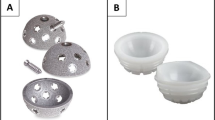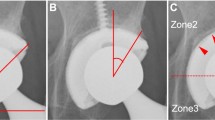Abstract
Purpose
Highly porous cups were developed to improve osseointegration and reduce the rate of aseptic loosening. Highly porous titanium cups could mix the reliability of titanium metal with an enhanced porosity, improving the bony ingrowth. The aim of this report was to assess the survival rates and reasons for revision of a highly porous titanium cup, Fixa Ti-Por (Adler Ortho, Milan, Italy), fabricated using an additive manufacturing.
Methods
The Registry of Prosthetic Orthopedic Implants (RIPO), the Emilia-Romagna region arthroplasty registry, was enquired about cementless cups, implanted since July 2007. Ti-Por cups were compared to all the other cementless sockets, acting as a control group. The survival rates and reasons for revision were evaluated and compared. Comparisons with the same articular couplings were also provided.
Results
When all the articular couplings were included, Ti-Por performed better, achieving a statistically higher survival rate than the control group (98.7% vs 97.9%) and a statistically lower incidence of cup aseptic loosening. In case of ceramic on polyethylene couplings, Ti-Por achieved similar survival rate: cup aseptic loosening in Ti-Por group was 0.2%, whereas the control group rated 0.4%. In ceramic-on-ceramic implants, the survival rate was similar in the two groups, Ti-Por achieving a cup aseptic loosening rate of 0.1% (vs 0.14% in the control group).
Conclusion
Highly porous titanium cups showed trustworthy results at eight years, reducing the rate of aseptic loosening. Longer follow-ups, ion analyses, and pre-clinical in vivo studies would be helpful to better define the reliability of these devices and their advantages.





Similar content being viewed by others
References
Hamilton WG, Calendine CL, Beykirch SE, Hopper RH Jr, Engh CA (2007) Acetabular fixation options: first-generation modular cup curtain calls and caveats. J Arthroplast 22(4 Suppl 1):75–81
Naziri Q, Issa K, Pivec R, Harwin SF, Delanois RE, Mont MA (2013) Excellent results of primary THA using a highly porous titanium cup. Orthopedics 36(4):390–394
Aslanian T (2017) All dual mobility cups are not the same. Int Orthop 41(3):573–581. https://doi.org/10.1007/s00264-016-3380-3
Macheras GA, Lepetsos P, Leonidou AO, Anastasopoulos PP, Galanakos SP, Poultsides LA (2017) Survivorship of a porous tantalum monoblock acetabular component in primary hip arthroplasty with a mean follow-up of 18 years. J Arthroplast 32(12):3680–3684
Lewallen EA, Riester SM, Bonin CA et al (2015) Biological strategies for improved osseointegration and osteoinduction of porous metal orthopedic implants. Tissue Eng Part B Rev 21(2):218–230
Bobyn JD, Stackpool GJ, Hacking SA, Tanzer M, Krygier JJ (1999) Characteristics of bone ingrowth and interface mechanics of a new porous tantalum biomaterial. J Bone Joint Surg Br 81(5):907–914
Baad-Hansen T, Kold S, Nielsen PT, Laursen MB, Christensen PH, Soballe K (2011) Comparison of trabecular metal cups and titanium fiber-mesh cups in primary hip arthroplasty: a randomized RSA and bone mineral densitometry study of 50 hips. Acta Orthop 82(2):155–160
Weiss RJ, Hailer NP, Stark A, Kärrholm J (2012) Survival of uncemented acetabular monoblock cups: evaluation of 210 hips in the Swedish Hip Arthroplasty Register. Acta Orthop 83(3):214–219
Ohldin, Patrik (2010). Series production of CE-certified orthopedic implants with integrated porous structures for improved bone ingrowth. Annals of DAAAM & Proceedings. http://www.freepatentsonline.com/article/Annals-DAAAM-Proceedings/246014358.html. Accessed 17 Jan. 2018
Regis M, Marin E, Fedrizzi L, Pressacco M (2015) Additive manufacturing of trabecular titanium orthopedic implants. MRS Bull 40(2):137–144
Taniguchi N, Fujibayashi S, Takemoto M et al (2016) Effect of pore size on bone ingrowth into porous titanium implants fabricated by additive manufacturing: an in vivo experiment. Mater Sci Eng C Mater Biol Appl 59:690–701
Registro dell’Implantologia Protesica Ortopedica (2015). https://ripo.cineca.it/. Accessed 21-01-2018
López-Torres II, Sanz-Ruíz P, Sánchez-Pérez C, Andrade-Albarracín R, Vaquero J (2018) Clinical and radiological outcomes of trabecular metal systems and antiprotrusion cages in acetabular revision surgery with severe defects: a comparative study. Int Orthop 42(8):1811–1818. https://doi.org/10.1007/s00264-018-3801-6
Steno B, Kokavec M, Necas L (2015) Acetabular revision arthroplasty using trabecular titanium implants. Int Orthop 39(3):389–395. https://doi.org/10.1007/s00264-014-2509-5
Perticarini L, Zanon G, Rossi SM, Benazzo FM (2015) Clinical and radiographic outcomes of a trabecular titanium™ acetabular component in hip arthroplasty: results at minimum 5 years follow-up. BMC Musculoskelet Disord 16:375
Orthopaedic Data Evaluation Panel (2018). http://www.odep.org.uk/product.aspx?pid=325. Accessed 21-01-2018
Kärrholm J (2017) CORR insights®: does the risk of rerevision vary between porous tantalum cups and other cementless designs after revision hip arthroplasty? Clin Orthop Relat Res 475(12):3023–3025
Laaksonen I, Lorimer M, Gromov K et al (2017) Does the risk of rerevision vary between porous tantalum cups and other cementless designs after revision hip arthroplasty? Clin Orthop Relat Res 475(12):3015–3022
Author information
Authors and Affiliations
Corresponding author
Ethics declarations
Conflict of interest
The authors declare that they have no conflict of interest.
Ethical approval
Ethical approval was not necessary as the registry collects personal data as standard practice and conceals the identity of the patients.
Rights and permissions
About this article
Cite this article
Castagnini, F., Bordini, B., Stea, S. et al. Highly porous titanium cup in cementless total hip arthroplasty: registry results at eight years. International Orthopaedics (SICOT) 43, 1815–1821 (2019). https://doi.org/10.1007/s00264-018-4102-9
Received:
Accepted:
Published:
Issue Date:
DOI: https://doi.org/10.1007/s00264-018-4102-9




